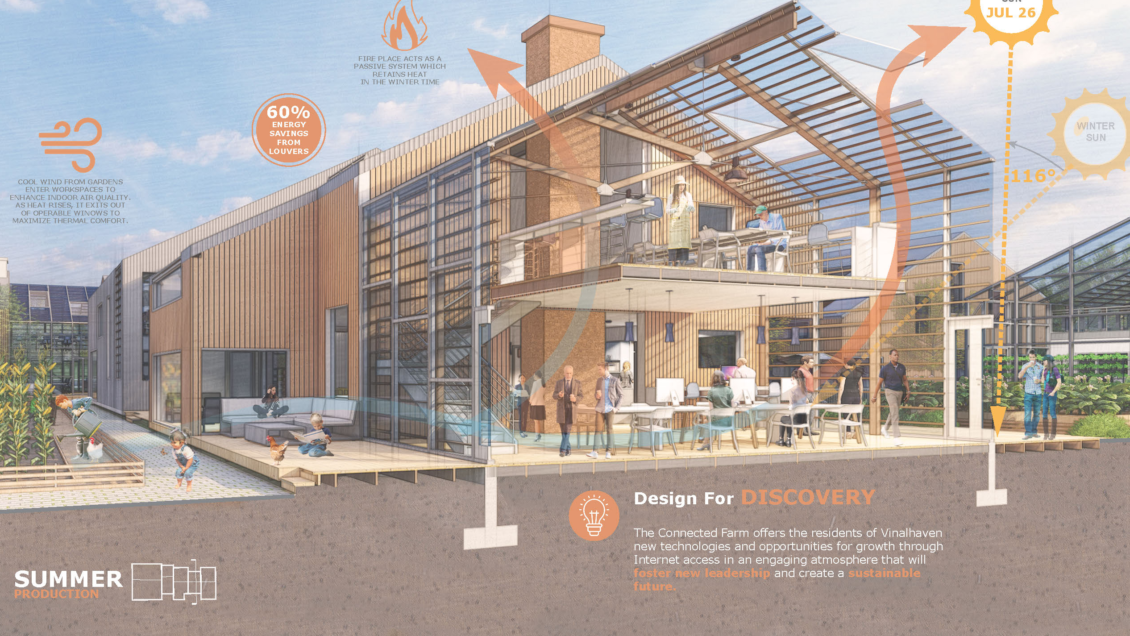For the sixth year in a row, Clemson Master in Architecture students have been recognized by the American Institute of Architects’ Committee on the Environment (AIA COTE). Each year, the COTE Top Ten for Students Competition celebrates sustainable design excellence, and this year Clemson students produced one of the 10 winning proposals from across the country. The proposals were completed in the Fall 2021 design studio taught by Associate Professor Ulrike Heine, Associate Professor David Franco, Senior Lecturer George Schafer and Assistant Professor Andreea Mihalache.
Designed to connect generations
This year’s winning proposal, “The Connected Farm,” is a project by Clemson students Gauge Bethea and Jesse Blevins. It is an intergenerational communal housing project designed to be self-sustainable through resource efficiency and agriculture.
The site accommodates housing for 96 residents with 24 ADA-accessible rooms. Each building uses sustainable strategies to reduce energy consumption and water demand. The design also incorporates local materials for affordability and reduction of the overall carbon footprint.
“When we explore, as we do in this studio, new architectures that respond to the environmental challenge, we cannot forget its social and political components,” Franco said.
“Designing, as students do with us, to combat urban homelessness or to shelter refugees on the Mexican border, is a form of empowerment that elevates these marginalized groups above climate change, and towards a more just future.”

“The Connected Farm” aims to address challenges on the island of Vinalhaven, Maine, including shortage of sustainable housing, seasonal job instability and insufficient resources such as internet access. Taken together, those challenges lead to island flight for young individuals and generational disconnect for those aging in place. The solution devised by Bethea and Blevins is to create a community that is 100% self-sufficient to reduce housing costs, supply year-round income opportunities through agriculture and technology-based jobs and provide a one-stop-shop that promotes connection among all generations. The farm creates a thriving community that promotes human connection among all generations by providing access to social spaces, technology, and a live-work environment. Throughout the site, there are multiple means of income opportunities through technology and agriculture which provides year-round food production and incentives to stay on the island.
The Clemson commitment and legacy
“I am very proud of our students and faculty for being recognized for the sixth year in a row by the national COTE awards,” said Jim Stevens, director of the School of Architecture. “The Clemson School of Architecture is committed to preparing students to design a more resilient and sustainable built environment and the COTE awards are evidence of our success.”
Projects created at Clemson have received eight of the 60 COTE student honors in the past six years, representing a full 13 percent of the awards presented nationwide. “The annual successes reflect the School of Architecture’s commitment to sustainability and excellence in design,” Stevens said.
AIA developed its Committee on the Environment because architects play a key role in addressing the effects of climate change through the design of the built environment. The committee and its annual competitions help prepare students to predict needs and create adaptive and resilient structures. The winning COTE student projects will be displayed on the AIA website. Winning students will also receive an honorarium and online mentoring opportunities with professional architects.
About the College of Architecture, Arts and Humanities
Established in 1996, the College of Architecture, Arts and Humanities celebrates a unique combination of disciplines—Architecture; Art; City Planning; Construction Science and Management; English; History; Languages; Performing Arts; Philosophy; Religion; Real Estate Development and interdisciplinary studies—that enable Clemson University students to imagine, create and connect. CAAH strives to unite the pursuit of knowledge with practical application of that knowledge to build a better and more beautiful world.
Get in touch and we will connect you with the author or another expert.
Or email us at news@clemson.edu

